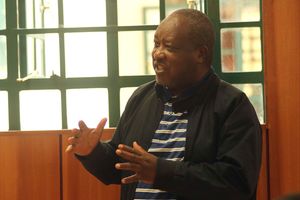
A general view of the State House, Nairobi the official residence of the President of Kenya, in Nairobi on December 18, 2023.
State House and New Kenya Cooperative Creameries (KCC) have 975 employees on the payroll but who are not captured in the staff register, topping the list of public entities with unexplained differences between staff captured in registers against those reported in the approved filled vacancies.
The Public Service Commission's (PSC) latest disclosures on the status of compliance of government entities with the values and principles of the Constitution say there was an excess of 19,467 members of staff recorded in the staff registers against those reported in the approved filled vacancies.
The PSC report named State House and New KCC among the six organisations that had high disparities with an excess of over 400 members of staff each, compared to the staff recorded in the staff register and called for an audit to explain this.
State House had 483 while New KCC had 492 employees that were not captured in the staff register in the year ended June 2023, coming in the period 289 other government organisations had fewer staff than approved at an average of 33 per cent.
“The number of staff in the staff registers did not tally with the number of vacancies filled. The unexplained variance could create room for unauthorised recruitment of staff,” said the PSC.

The entrance to New Kenya Cooperative Creameries factory in Eldoret, Uasin Gishu County, in February last year.
“An audit be undertaken to establish the reason for the variance of the number of staff in the staff registers against the number of vacancies filled.”
National Treasury estimates show that national government spending on salaries and wages is expected to cost taxpayers Sh589.5 billion in the financial year ending June 2024, up from Sh539.6 billion in the previous financial year. This is projected to hit Sh983.8 billion in 2027/2028.
PSC states the Constitution requires PSC to promote, evaluate, and report to the President and Parliament the extent to which the values and principles in Articles 10 and 232 have been complied with. This means President William Ruto will be appraised about the compliance gaps, part of which lie in State House.
The unexplained staff raises fears that taxpayers could be spending billions of shillings every month to pay non-existent workers or a mystery workforce with no known official duties. This is even as the public suffers in the hundreds of other entities which are understaffed and unable to serve citizens.
“An organisation that operates with less staff against the approved staff levels is understaffed and therefore unlikely to discharge its mandate efficiently and effectively. Organisations that operate with excess staff levels may lead to under-utilisation of staff, bloated wage bills, and strained workplace facilities,” said the PSC.
Service delivery
The PSC report is based on findings from 523 public organisations that were surveyed to find their compliance with values and principles in areas such as service delivery, professional ethics, good governance, transparency, accountability, performance management and good use of taxpayers’ money. The overall compliance index was 46.01 per cent, a slight improvement from 41.7 per cent.
PSC found 15 organisations with excess staff against the approved staff levels, meaning that taxpayers are also footing wages and salaries of employees who are not supposed to be working in those entities.
Five of the 15 entities had excess staff members of over 50 per cent. Kenya Medical Supplies Authority (Kemsa) led with staff levels of 115 per cent when compared to approved levels, followed by the National Water Harvesting and Storage Authority (72 per cent), State Department for Devolution (61 per cent), State Department for Higher Education and Research (69 per cent), and State Department for Immigration and Citizen Services (59 per cent).







